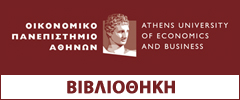| Abstract : | Ο πιστωτικός κίνδυνος είναι ένας τομέας στον οποίο χρησιμοποιείται η Στατιστική και η Μηχανική Μάθηση. Λόγω της φύσης του πιστωτικού κινδύνου, ένα μοντέλο το οποίο μπορεί να εξηγηθεί είναι πολύ σημαντικό και πολλές φορές υποχρεωτικό. Σε αυτή την εργασία έγινε μια βιβλιογραφική αναφορά σε πρόσφατες μεθόδους επεγηγηματικότητας της τεχνητής νοημοσύνης. Αυτές οι μέθοδοι παρουσιάστηκαν λεπτομερώς. Πολλαπλά μοντέλα εκπαιδεύτηκαν στα δεδομένα όπως λογιστική παλινδρόμηση και άλλα μοντέλα μηχανικής μάθησης. Η σύγκριση των μοντέλων έγινε με βάση την ικανότητα τους να προβλέπουν σε νεα δεδομένα. Έπειτα, οι μέθοδοι επεξήγησης εφαρμόστηκαν στη λογιστική παλινδρόμηση έτσι ώστε να ελεγθεί ότι συμφωνούν με τη παραδοσιακή μέθοδο συμπερασματολογιας. Επίσης εφαρμόστηκαν στο καλύτερο μοντέλο μηχανικής μάθησης σε μια προσπάθεια να κατανοηθεί το πως δουλεύει ο αλγόριθμος και πως κάνει τις προβλέψεις του.
Quantifying credit risk is an application where both Statistics and Machine Learning are used. However, due to the nature of credit risk, an interpretable model is of paramount importance and sometimes mandated by law. In this thesis, a literature review was done on recent methods of A.I explainability. The methods were presented in a detailed mathematical formulation. Various models were fit to the data including logistic regression and various machine learning contender models. The models were compared using their predictive ability on new data. Then the methods of interpretability were applied to the logistic regression model to make sure they agree with the traditional method of inference. They were also applied to the best performing machine learning model. This was an attempt to peek into the black box nature of the algorithm and understand how it works and why it makes the predictions it does.
|
|---|







 Copyright © 2013 Library AUEB. All rights reserved.
Copyright © 2013 Library AUEB. All rights reserved.